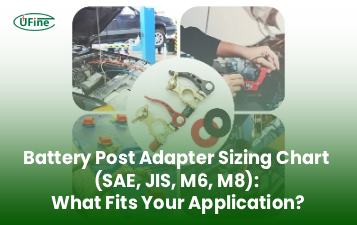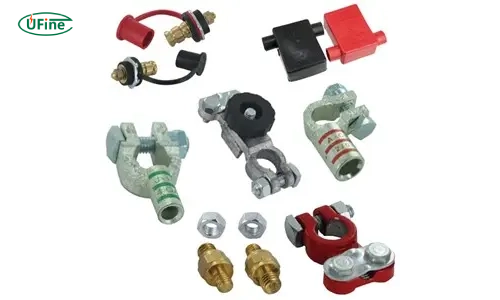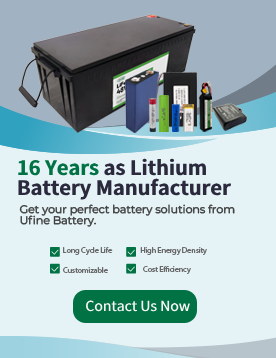
- Part 1. What is a battery post adapter?
- Part 2. Battery post adapter types and which one you need
- Part 3. Battery post adapter compatibility and why size matters
- Part 4. When a battery post adapter is actually needed
- Part 5. Battery post adapter installation and basic safety rules
- Part 6. Battery post adapter performance and how adapters affect resistance
- Part 7. Battery post adapter safety tips for LiFePO₄ batteries
- Part 8. FAQ: Battery post adapter
Battery post adapters may appear simple, but they have a significant impact on electrical reliability, system compatibility, and long-term safety. Whether upgrading to LiFePO₄ batteries, replacing lead-acid units, installing a new energy system, or adapting existing cables, the correct adapter ensures strong electrical contact and reduces the risk of resistance, overheating, or intermittent power loss.
This guide explains everything you need to know before choosing or installing a battery post adapter: its types, compatibility rules, correct use cases, installation principles, performance considerations, and safety recommendations—especially for lithium batteries.
Part 1. What is a battery post adapter?
A battery post adapter is a metal component designed to convert one terminal type into another—for example, turning an M6 or M8 threaded lithium terminal into a standard SAE automotive post. This makes it possible to install modern lithium batteries into systems originally built for lead-acid batteries without replacing factory cables or modifying connectors.
Lithium batteries often use threaded terminals, while many vehicles and equipment still use round posts. A battery post adapter bridges that gap safely and efficiently.
Part 2. Battery post adapter types and which one you need
Battery post adapters vary by shape, size, and application. Selecting the wrong type may lead to excessive resistance, loose connections, or mechanical stress on the battery terminal.
1 SAE battery post adapter (automotive standard)
SAE posts are the most common in cars, RVs, ATVs, and marine applications. They convert threaded terminals into standard automotive posts.
2 JIS battery post adapter (Japanese small standard)
JIS posts are slightly smaller and used in motorcycles, Japanese vehicles, and compact power systems. If your cables don’t fit an SAE post, you may need a JIS-size adapter.
3 M6/M8 battery post adapter for lithium batteries
Most LiFePO₄ batteries use:
- M6 terminals (small packs, <20Ah)
- M8 terminals (medium to large packs, 20–300Ah)
These adapters convert a threaded stud into:
- SAE posts
- JIS posts
- Extended studs for ring terminals
- Multi-purpose dual-post adapters
M6/M8 compatibility is critical because thread mismatch can permanently damage a lithium terminal.
4 Universal clamp-type battery post adapter
These adapters fit multiple sizes but often sacrifice accuracy and contact stability.
Not recommended for high-current LiFePO₄ systems due to insufficient surface contact.
5 Material differences in battery post adapters (Copper, brass, lead)
Material selection affects conductivity and durability:
| Material | Conductivity | Corrosion Resistance | Best Use |
|---|---|---|---|
| Copper | Excellent | High | High-current lithium systems |
| Brass | Good | Very high | Marine, humid environments |
| Lead | Low | Low | Legacy lead-acid systems |
For lithium, copper or brass adapters are strongly preferred.
Part 3. Battery post adapter compatibility and why size matters
Compatibility requires matching the following:
- Terminal type → M6 / M8 / SAE / JIS
- Thread pitch → Correct threading avoids stripping
- Current load → High-current systems require high-conductivity materials
- Cable type → Ring terminals vs clamp terminals
Incorrect sizing leads to:
- Increased electrical resistance
- Voltage drop
- Overheating at the connection point
- Terminal deformation
- Vibration-induced loosening
Artikel Terkait: Battery Post Adapter Sizing Chart
Part 4. When a battery post adapter is actually needed
Battery post adapters are extremely useful—but only when used correctly. They should be used to improve compatibility and safety, not as a universal workaround.
1 Upgrading from lead-acid to LiFePO₄ batteries
Most lithium batteries use threaded terminals rather than posts.
Adapters allow a true drop-in installation.
This is the most common use case for battery post adapters.
2 When your cables use ring terminals
Ring terminals require:
- Stud extenders
- Post-mount adapters
- Threaded post converters
These ensure a stable, vibration-resistant connection.
3 Converting M6/M8 terminals to SAE automotive posts
Used in:
- RV power systems
- Marine trolling motors
- Mobility scooters
- Solar battery banks
4 Protecting lithium battery terminals from mechanical stress
Adapters absorb torque, tightening force, and vibration, helping prevent:
- Thread stripping
- Deformation
- Terminal plate damage
This extends the lifespan of lithium terminals, which are more delicate than lead-acid posts.
5 When NOT to use a battery post adapter
Avoid using an adapter when:
- You need multiple adapters stacked together
- The adapter is made of poor conductive material
- The system draws extremely high surge current
- The fit is loose or unstable
- The original cable can be easily replaced instead
Part 5. Battery post adapter installation and basic safety rules
Correct installation is crucial for lithium batteries, which require stable, low-resistance connections.
- Keep the adapter flush against the terminal
- Do not overtighten (lithium terminals can be damaged)
- Use proper torque specifications
- Ensure full metal-to-metal contact
- Avoid universal clamps in high-current systems
- Apply corrosion protection in marine environments
Part 6. Battery post adapter performance and how adapters affect resistance
A high-quality copper or brass adapter adds minimal resistance.
However, performance issues occur when:
- The adapter is too loose
- The surface contact area is low
- Material conductivity is poor
- There is corrosion or oxidation
- Multiple adapters are stacked
Consequences include:
- Voltage drop
- Connector heating
- Power loss under load
- Reduced overall system efficiency
Part 7. Battery post adapter safety tips for LiFePO₄ batteries
LiFePO₄ terminals require careful handling, because:
- They use softer metal plates
- Threaded inserts can be damaged by overtightening
- High discharge current amplifies resistance issues
Recommended practices:
- Always match thread size (M6 vs M8)
- Use copper or brass adapters
- Follow torque guidelines
- Recheck tightness after vibration or transport
- Avoid universal oversized clamps
Part 8. FAQ: Battery post adapter
What size battery post adapter do I need for my LiFePO₄ battery?
Most small LiFePO₄ batteries use M6 terminals, while medium and large models use M8. Always match the thread size and pitch before choosing an SAE or JIS adapter.
Can a battery post adapter reduce performance?
Yes, poor-quality adapters or loose connections can increase resistance, causing voltage drop and heat. High-conductivity copper or brass adapters minimize this issue.
Is it safe to tighten a battery post adapter firmly on lithium terminals?
You must not overtighten lithium battery terminals. Follow torque guidelines to avoid damaging threaded inserts or deforming internal plates.
When should I avoid using a battery post adapter?
Avoid adapters in extremely high-current systems, when multiple adapters are required, or when the adapter fit is loose. In such cases, replacing the cable is safer.
Do I need a battery post adapter when replacing a lead-acid battery with LiFePO₄?
In most cases, yes—because lithium batteries use threaded terminals. An adapter enables a clean drop-in replacement without modifying your existing cables.
Related Tags:
More Articles

Battery Post Adapter Sizing Chart (SAE, JIS, M6, M8): What Fits Your Application?
Find the right battery post adapter with our sizing chart for SAE, JIS, M6, and M8 terminals. Ensure compatibility with your lithium battery setup.
How to Choose & Maintain the Perfect Moped Battery
Discover the right moped battery, replacement tips, and maintenance strategies for peak performance.
Comprehensive Understanding of 7.4 V Battery [Updated in 2025]
Discover the world of 7.4V batteries - from understanding the differences to learning how to charge and use them effectively. Dive into this comprehensive guide now!
Hydride Battery Explained: Benefits, Uses & Charging Tips
Understand hydride battery operation, lifespan, and maintenance. Find out how NiMH batteries power modern devices and hybrid cars.
Should You Buy a Maintenance-Free Battery?
Learn what a maintenance-free battery is, its pros, cons, types, and how to know if it’s the right choice for your car or motorcycle.




